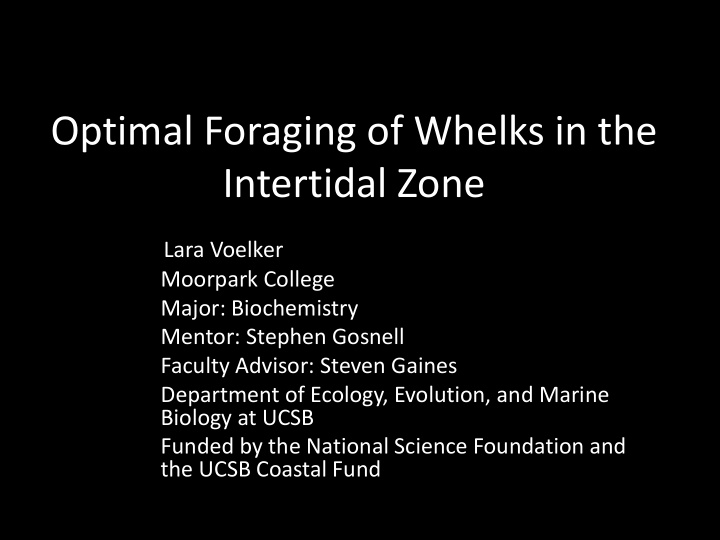



Optimal Foraging of Whelks in the Intertidal Zone Lara Voelker Moorpark College Major: Biochemistry Mentor: Stephen Gosnell Faculty Advisor: Steven Gaines Department of Ecology, Evolution, and Marine Biology at UCSB Funded by the National Science Foundation and the UCSB Coastal Fund
Understanding Community Dynamics Maintain Biodiversity as keystone predators (Paine, 1969) Understand community dynamics to understand how communities may change Picture by Sean Trek, 2005
Optimal Foraging Optimal Foraging: why do they eat what they eat? Goal Determine: • What provides most energy • What allows the most growth • What they choose to eat due to other factors Image courtesy of www.wikipedia.org
Dissecting Mussels
Larger mussels have exponentially more edible tissue
Growth Experiments - Mussel Size Prey Sample Predator Size Sample Size >30 mm 25 mussels 15 whelks 30-50mm 25 mussels 15 whelks 50-70mm 25 mussels 15 whelks
Growth in the Lab
Growth in the Field
What do they eat? -Mussel shells that evidenced predation were within a specific size range -Whelks are capable of consuming both very large and very small mussels -There is no clear correlation between the size of whelks that were observed feeding and the size of mussel they were consuming
Conclusions - Larger mussels are more tissue-rich per millimeter -Smaller mussels appear to optimize growth in whelks -Preference of prey is not random
Future Plans -Determine relationship between energy content of mussels and size -Determine drilling rates -Determine impacts of other factors (predators, wave action)
Acknowledgements Thank you to the following for your hard work and support: INSET Staff Mentor: Stephen Gosnell Faculty Advisor: Steven Gaines Friends and Family
Recommend
More recommend